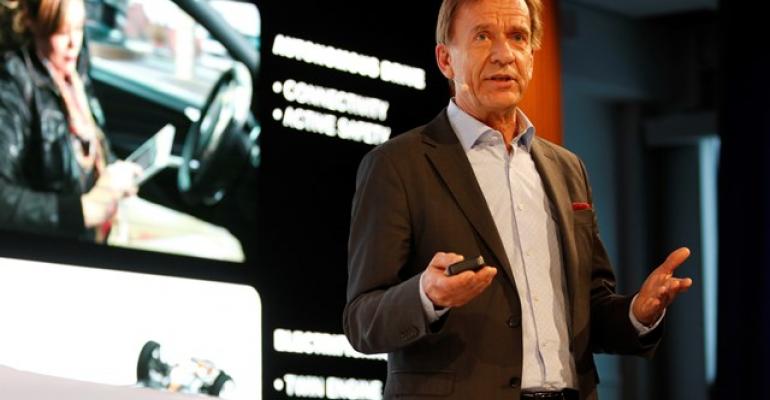ROMULUS, MI – Autonomous drive represents the next big step in luxury-vehicle appeal and profitability, Volvo CEO Håkan Samuelsson says.
The Swedish automaker, which is developing a Level 5 autonomous vehicle – no steering-wheel or pedals – in a partnership with ride-hire firm Uber, should have similar vehicles with full auto-pilot technology available in the retail market within five years, Samuelsson says.
Expect consumers to be willing to pay a $10,000 premium for the upcoming self-driving capability, he predicts.
“Autonomous technology will make premium cars more attractive and profitable,” the Volvo CEO tells reporters following a speech to the World Mobility Leadership Forum here. “Once you drive it, you don’t want to be without it.”
Volvo has a dual-track program under way that will turn a purpose-built autonomous-vehicle platform, now in development and based on the XC90 CUV’s Scalable Product Architecture, into two different styles of self-driving vehicles, one for Uber and the other for the general public.
The Uber project will see the modified XC90s built as Level 5 vehicles, incorporating control software developed by the ride-sharing firm. The two companies are splitting the reported $300 million development cost of the program. Uber plans to put the advanced-technology vehicles into regular service by 2021.
The retail model, a Level 4 autonomous vehicle equipped with steering wheel and pedals, also is expected around 2021 and will utilize control software developed jointly with Swedish automotive safety-systems giant Autoliv. About 100 of the vehicles will be placed in the hands of consumers for road tests beginning next year in the U.K. and the following year in China.
The Level 4 vehicles aimed at consumers will be designed to operate along freeways and other roads without driver monitoring, with Volvo positioning the technology as a step up from its current Pilot Assist system that requires the driver to keep his hands in frequent contact with the steering wheel.
“There needs to be a very clear divider,” Samuelsson says of the currently available, less-sophisticated driver-assist technology and upcoming more advanced Level 4 vehicle that will fully pilot itself, then signal to the driver in a “slow, 2- to 3-minute wake-up process” when it is time to retake control.
Ford, which also is in a test program with Uber, says it will deliver autonomous vehicles to consumers around 2025, but it plans to skip the Level 4 phase and offer consumers only Level 5 automated vehicles without steering wheels or pedals.
Both automakers say they are developing unique architectures for their driverless vehicles because fully autonomous cars will require a number of backup systems to ensure safety, and it’s not possible to retrofit all that into an existing vehicle layout.
“(Everything) has to be fully redundant – braking systems, steering systems, batteries, everything, if you’re really going to have Level 4 or 5 autonomous cars,” Samuelsson says.
The CEO believes his company’s long-held reputation for safety will give it a leg up in the autonomous-vehicle market.
“We think safety will be paramount (to consumers), which is one of the most valuable assets of Volvo and Autoliv,” he says.
Volvo also is exploring a car-sharing business that would give its buyers a chance to loan out their vehicles when not in use. Those services already exist, but Samuelsson believes there’s room for the automaker to create a business around ensuring participating Volvo owners get their cars back clean, “without scratches and with fuel in the tank.”
Vehicle-sharing might impact Volvo profitability if it causes it to sell fewer cars, the executive admits, “but we should try not to resist it.”
[email protected] @DavidZoia





